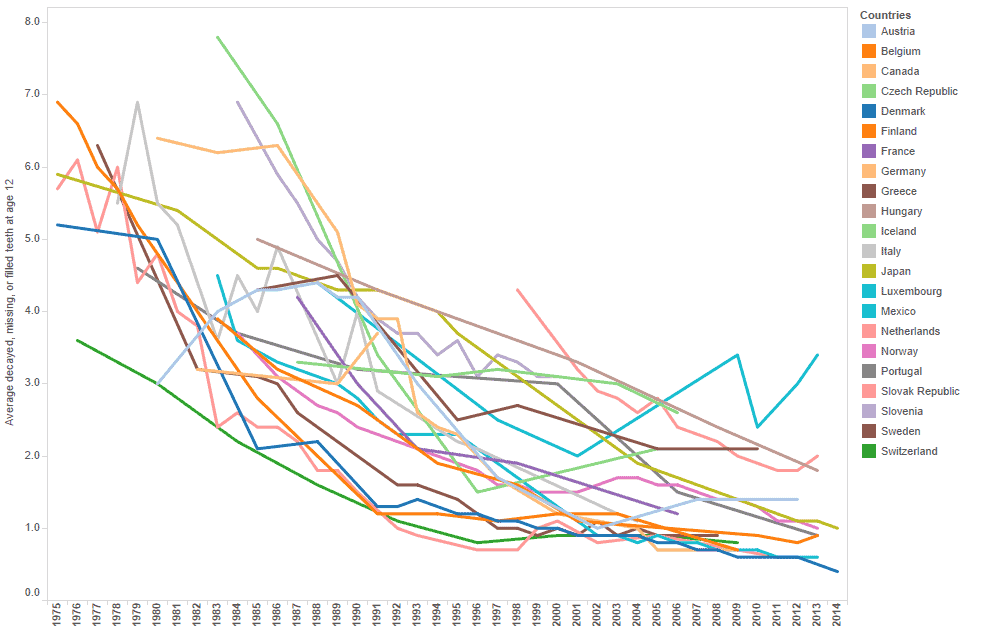Is Fluoridated Drinking Water Safe?
Mineral fluoride in our community drinking water supply has been debated ever since it was introduced back in the mid-1940s with the aim to prevent tooth decay. The evidence is mounting that in an era of fluoridated toothpaste and other dental health consumer products, the potential risks from consuming fluoridated water may outweigh the benefits. Many health concerns expressed by the opposition have to date been largely dismissed until recently.
Last year (2016), Harvard Public Health Magazine released an article outline a worldwide study comparing “Countries that do not fluoridate their water compared to Countries that do, have also seen big drops in the rate of cavities”.
Below is a snip-net of the article and a link to the full article.
Read the full article:
https://www.hsph.harvard.edu/magazine/magazine_article/fluoridated-drinking-water/
The Evidence (Summary)
Beginning in the early 20th century, scientists linked high levels of naturally occurring fluoride in certain community water supplies to low levels of tooth decay. In 1945, Grand Rapids, Michigan, became the first community in the world to add fluoride to tap water. When subsequent studies showed a significantly lower rate of cavities in schoolchildren, water fluoridation spread to other towns and cities. U.S. Centers for Disease Control and Prevention named community water fluoridation one of the 10 great public health achievements of the 20th century.
But many experts now question the scientific basis for the intervention. In June 2015, the Cochrane Collaboration—a global independent network of researchers and health care professionals known for rigorous scientific reviews of public health policies—published an analysis of 20 key studies on water fluoridation. They found that while water fluoridation is effective at reducing tooth decay among children, “no studies that aimed to determine the effectiveness of water fluoridation for preventing caries [cavities] in adults met the review’s inclusion criteria.”
The Cochrane report also concluded that early scientific investigations on water fluoridation (most were conducted before 1975) were deeply flawed. “We had concerns about the methods used, or the reporting of the results, in … 97 percent of the studies,” the authors noted. One problem: The early studies didn’t take into account the subsequent widespread use of fluoride-containing toothpaste and other dental fluoride supplements, which also prevent cavities. This may explain why countries that do not fluoridate their water have also seen big drops in cavity rates (see chart below).
Countries Without fluoridated water

Countries With fluoridated water

Moreover, fluoride itself may be dangerous at high levels. Excessive fluoride causes fluorosis—changes in tooth enamel that range from barely noticeable white spots to staining and pitting. Fluoride can also become concentrated in bone—stimulating bone cell growth, altering the tissue’s structure, and weakening the skeleton.
Perhaps most worrisome is preliminary research in laboratory animals suggesting that high levels of fluoride may be toxic to brain and nerve cells. And human epidemiological studies have identified possible links to learning, memory, and cognition deficits, though most of these studies have focused on populations with fluoride exposures higher than those typically provided by U.S. water supplies.
Comments by Philippe Grandjean, adjunct professor of environmental health, Harvard T.H. Chan School of Public Health:

“We should recognize that fluoride has beneficial effects on dental development and protection against cavities. But do we need to add it to drinking water so it gets into the bloodstream and potentially into the brain? To answer this, we must establish three research priorities.
“First, since dental cavities have decreased in countries both with and without water fluoridation, we need to make sure we are dosing our water with the proper amount of fluoride for dental medicine purposes, but no more.
“Second, we need to make sure fluoridation doesn’t raise the risk of adverse health effects. In particular, we need basic research on animals that would help us understand the mechanisms by which fluoride may be toxic to the developing brain.
“Third, we need to find out if there are populations highly vulnerable to fluoride in drinking water—bottle-fed infants whose formula is made with tap water, for example, or patients undergoing dialysis. If these individuals are at risk, their water must come from a source that is lower in fluoride.”
*This description of the Cochrane Collaboration’s findings in relation to water fluoridation and adult cavities is a clarification of the text in the print edition of the Spring 2016 Harvard Public Health, where this article originally appeared.
Nicole Davis is a science writer and communications consultant specializing in biomedicine and biotechnology. She holds a PhD in genetics from Harvard University.
Fluoridated toothpaste and other dental health consumer products seem to mirror the benefits of fluoridated water but the potential health risks of consuming fluoridated water are still there… What can we do as consumers? We can choose to reduce the potential risks of consuming fluoridated water…
The Good News is, There are water filters available today that can considerably reduce the levels of fluoride levels in our drinking water. The UltraStream is one of the best.
It not only reduces Fluoride but it takes out Bacteria, Heavy Metals, Chlorine and Chloramines, Sediment and removes Bad Taste and Odor. It Alkalises, Ionises and softness the water, add Magnesium, Calcium and infuses the water with Molecular Hydrogen. And… it’s extremely affordable!
Learn More about the UltraStream
References:
- Fluoride Action Network. Dental Fluorosis.
- Schellenberg D, Marks TA, Metzler CM, Oostveen JA, Morey MJ. Lack of effect of fluoride on reproductive performance and development in Shetland sheepdogs. Vet Hum Toxicol. 1990 Aug;32(4):309-14. Erratum in: Vet Hum Toxicol 1990 Dec;32(6):527.
- Fluoride Action Network. Gastrointestinal.
- Martijn W. H. Pinkse, Maarten Merkx, Bruce A. Averill. Fluoride Inhibition of Bovine Spleen Purple Acid Phosphatase: Characterization of a Ternary Enzyme−Phosphate−Fluoride Complex as a Model for the Active Enzyme−Substrate−Hydroxide Complex. Biochemistry. 1999 July 20. 38 (31), pp 9926–9936 DOI: 10.1021/bi990446w
- Michael Connett, Tara Blank PhD. Fluoride & Intelligence: The 36 Studies. Fluoride Action Network. 2012 December 9.
- Fluoride Action Network. Water Fluoridation.https://www.alkaway.com.au/learning-centre/water-filtration/fluoride-the-latest-poison-in-our-water/


